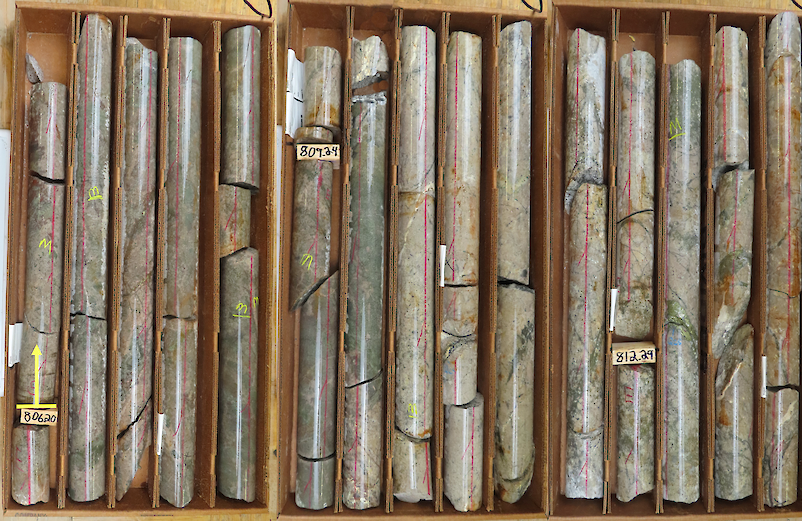The Gold Report: Mike, the prevailing wisdom in the market favors producers over explorers in the precious metals equities. The thinking seems to be why buy the pasture when entire farms are selling at nearly the same price? What do you think of that strategy?
Mike Kachanovsky: That is a good summary of current affairs. Market values for the entire sector have been trimmed dramatically; even many of the highest rated stocks are down 50% to 60%. From a value perspective, it makes sense to buy higher up the food chain when you have the opportunity, to buy more established companies that offer legitimate earnings and established infrastructure.
TGR: Kenneth Hoffman of Bloomberg Research notes that production from the world's biggest gold mines has dropped 17% since early 2011. He predicts that gold mines, especially high-cost mines in Africa, will start to close as gold hovers around $1,200/ounce ($1,200/oz). Is there a bullish medium-term case to be made for gold given the shrinking supply?
MK: We have been through similar severe price corrections before. At the beginning of this century, gold's market value was below what it cost to produce it. Mines closed and companies went out of business. That scenario evolved into the bull market we have today and the achievement of all-time high metals prices.
TGR: But this is not a bull market.
MK: A lot of the mainstream commentary is telling us this is a bear market for gold. I consider this to be a very severe correction within the context of a long-term bull market, a volatile event that will lead back into an even more bullish case down the road. I think we will see new highs for both gold and silver before this is over.
TGR: Predicting how long this will last is not easy, but what is your best guess?
MK: In my last Gold Report interview just over a year ago, I thought we would see a recovery before the end of 2012. I was dead wrong, obviously. Trying to predict the timing is just asking to be proven wrong.
"I think we will see new highs for both gold and silver before this is over."
The longer we get into this correction, I believe we are setting up for an even higher and more vibrant recovery. I would like to think the selling pressure would be washed out by this fall, but who knows? Silly can always get sillier.
TGR: Could gold test the $1,000/oz threshold this summer?
MK: Putting this in perspective, when gold was setting new highs in 2011, we had a parabolic short-term price curve. People speculated the price would break through $2,000/oz on the upside. We are now looking at a parabolic decline, which is just as unsustainable as a parabolic rise.
TGR: If silver and gold do rebound, what will underpin those rebounds?
MK: Demand for actual physical bullion is running at all-time highs. That is what will trigger more bullish conditions.
"After metals prices have recovered, people will realize that mining stocks have been driven down to generational lows and money will rapidly flow back into the juniors."
Both gold and silver exist in finite quantities. Speculators are panicking at these low prices, but shrewd accumulators who understand that gold and silver have always been money are buying all they can at these prices.
I saw it for myself in Hong Kong this April: people lined up three deep screaming, wanting to buy metal. That demand, along with supply curtailed by the lack of new development projects, will cause a shortage. That will trigger the next new high in gold as the market reacts.
TGR: If investors do return to precious metals, what would that mean for junior mining stocks?
MK: After metals prices have recovered, people will realize that mining stocks have been driven down to generational lows and money will rapidly flow back into the juniors. The selling today comes from hedge funds, exchange-traded funds and mutual funds. The recovery will be the mirror image of that, when the same funds want to accumulate these stocks again.
TGR: Until then, what do junior precious metals equities need for you to make a bid on them?
MK: It still makes sense to look at explorers one-by-one and find companies that are sitting on a large cash position and good projects. Many good stories are priced at generational lows. Even in this weak market, it is a good time to accumulate companies positioned for the day sentiment swings back to more bullish. This is an opportunity to buy cheaply and establish positions at very low cost averages.
"Look at explorers one-by-one and find companies that are sitting on a large cash position and good projects."
But you must be selective. Warren Buffett once compared investing in stocks to playing a game of baseball where there are no called strikes. You have to wait and look for that really fat pitch to come across the middle of the plate before you swing the bat. The willingness to wait until you find that one company that is priced cheaply and has all the attributes to succeed will define the investors who make the most money after this downturn in market sentiment is resolved.
I look for companies with great cash positions, strong management, robust projects and low operating margins. Even really good stories are trading as if they were impaired.
TGR: You routinely make site visits. What mines or projects have you visited recently?
MK: I was at Scorpio Gold Corp. (SGN:TSX.V) in Nevada in April to tour its brand-new crushing plant at Mineral Ridge. That plant will allow the company to increase production and lower its unit cost.
Scorpio could well be one of the lower cost junior producers in Nevada, yet the stock has been a train-wreck. It is a good company priced at an almost ridiculous valuation, but it is well positioned to survive the downtrend and continue with its growth plan.
TGR: Scorpio settled a lawsuit in 2012 and seemed poised for better things in 2013, including more output at Mineral Ridge. Is its low price all market related or are there company-specific issues?
MK: I have been buying Scorpio all the way down, asking myself if I am missing something. Everything—cash costs, debt load, operations—looks sustainable and well-run. I have not been able to find a reason that justifies all this selling other than the overall weakness in the sector.
TGR: In late June, Atna Resources Ltd. (ATN:TSX) suspended operations at its Pinson mine in Nevada until a "revised operating plan is developed and gold prices are sufficient to support positive cash flow from operations." Is this strictly about the gold price or are things just getting tougher in Nevada?
MK: Things are tough everywhere. Cash costs in every significant gold-producing region of the world have risen more than the metals prices. Now that the metals have corrected, operating and profit margins are under severe pressure.
Whenever there is a longer term correction in prices, production will revert to the lowest margin producers; the smaller companies and the higher cost producers will be taken offline. That is what we are seeing now.
The oldest cliché in the commodities sector is that the best cure for low prices is low prices. The longer gold remains in its current price range, the more mines will go offline, limiting the gold supply. Low supply will eventually contribute to a recovery and to higher prices.
TGR: Rye Patch Gold Corp. (RPM:TSX.V; RPMGF:OTCQX) is another junior operating in Nevada. It recently settled with Coeur Mining Inc. (CDM:TSX; CDE:NYSE) over the Rochester mine claims. What does that settlement mean for its investors?
MK: First, the settlement with Coeur injected $10 million ($10M) in working capital upfront for Rye Patch to move ahead.
Second, it gives Rye Patch a revenue stream. The royalty part of the settlement will contribute another $28M of recurring income that Rye Patch can use to fund projects.
There is about $38M in cash value from the settlement, which works out to about $0.25/share in value, on a stock trading at about $0.19/share.
TGR: In other words, if you believed in Rye Patch before it staked the Rochester claims, you should really believe in it now.
MK: Exactly. I think the sellers in Rye Patch are speculators who bought in expectation of a bigger settlement and more of an upside as the lawsuit progressed.
I look at it from the other point of view: A lot of good companies are dead in the water with no access to capital. Rye Patch has now emerged as one of the best funded juniors, ready to spend on its other properties or to make acquisitions.
A stock that trades at $0.19/share has a clear path to survive this downturn and to take advantage of the low-price opportunities out there. I am buying it and plan to continue to buy as long as I can get shares in this price range.
TGR: You are well known as Mexico Mike. What are your favorite junior equities in Mexico?
MK: Mexico is one of the premier spaces for investors in the junior mining space. Many good companies have been active there for years, but today their price ranges are so low that you can accumulate them almost as new entrants.
I have been a fan of IMPACT Silver Corp. (IPT:TSX.V) since the company acquired its first project in Mexico more than 10 years ago. IMPACT has put three new mines into production in the last couple of years. The company is running at capacity and is a low-cost operator. It has an extremely strong cash position and a huge inventory of untested new targets for future growth.
This is a company you can hold with confidence even if this correction drags on.
TGR: What is IMPACT Silver's cash position?
MK: As of May 24, the working capital position was $16.8M, which is enough money to go for a while.
TGR: IMPACT Silver recently commissioned its 100%-owned Capire Production Centre. The company expects to begin concentrate shipments in the next six months. What will that add to IMPACT's bottom line?
MK: I am not sure what the bottom-line numbers will be. To me, Capire's significance is that it is being set up as a test mining operation. The company will be evaluating the strength of that whole mining area based on the small-scale operations of Capire.
In the early stages, the numbers are not as important as getting an idea of how the ore from that new zone will behave in a conventional processing environment. If it is profitable, IMPACT can redirect the cash flow back into expanding the operation and making it a much more significant production center.
TGR: Capire hosts high-grade, polymetallic mineralization. How important are byproduct credits to margins in this market?
MK: Most Mexican mines produce concentrates with silver in a zinc or a lead concentrate. The value of the concentrate itself has come down. These polymetallic mines get a lot of their total cash value from the base metals they produce along with the silver.
Silver has lost about 60% of its value off its peak, and other base metals have been affected by the same deflationary price trend. Right now both zinc and lead are at much lower price levels than when they were trading near their peaks. The companies will not gain as much benefit from byproducts as they did in the bull market.
TGR: What equities do you follow in Mexico?
MK: Like IMPACT, Great Panther Silver Ltd. (GPR:TSX; GPL:NYSE.MKT) has invested a lot in infrastructure. The company also has made significant discoveries. It improved the efficiency of its operations and can recover high percentages of the byproducts for every kind of ore that the company processes. Great Panther can use its strong cash position to continue investing in its operations and stay strong however long this correction continues.
TGR: Great Panther's president, Martin Carsky, recently announced his resignation. How will that affect the share price?
MK: Bob Archer, who helped build the company over the last 10 years, will succeed Carsky, so the analysts and the institutions know that the same committed person will be running the company in the short term. In the long term, it would be smart for Bob to appoint a new president and not wear as many hats.
TGR: Do you have another Mexican story?
MK: Avino Silver & Gold Mines Ltd. (ASM:TSX.V; ASM:NYSE.MKT; GV6:FSE) has been active in Mexico since the 1990s. The company invested in infrastructure and in developing a new mine. That improved its cash costs and the output is in a rising trend. The company has reported strong cash flow and has access to additional capital through a line of credit. It is well positioned to survive a long downtrend.
TGR: We saw Endeavour Silver Corp. (EDR:TSX; EXK:NYSE; EJD:FSE) buy El Cubo from AuRico Gold Inc. (AUQ:TSX; AUQ:NYSE) and turn that asset around. Do you expect any small producers, like those you just mentioned, to buy distressed assets and prepare them to produce if prices turn around?
MK: I doubt any of the smaller producers have the clout to acquire a producing mine at this point. They are not capitalized or funded to take on major new deals.
Instead, I think junior producers will start to merge in friendly transactions. Perhaps the overall sector weakness will encourage more management teams to sit down and agree to deals to make that happen. Friendly mergers could be a win-win for any of these smaller juniors.
TGR: Do you see a likely dance partner for Avino in that situation?
MK: There are probably a dozen strong producing juniors, any one of which would be a good candidate for a partnership. In some cases they are operating individual mines immediately adjacent to each other, working very similar projects.
It is just a question of whether or not management is willing to agree to a transaction. That has been the problem all the way through this market; the smaller juniors resisted any efforts to merge.
TGR: What prompts that reaction? Self-preservation? Ego?
MK: Most junior miners were built from the ground up by one or two people. For a merger to succeed, some of those senior people would have to hand over the reins to a new management structure where they are no longer leading the charge. That is a difficult transition, even if it makes better sense for the company as a whole.
Unless merger becomes a necessity, I think most management teams will continue to resist mergers. The market conditions of today may create that necessity.
TGR: Mike, you have made a lot of money in this space and obviously believe that can happen again. Can you share one unsung aspect of your success, a trick of the trade?
MK: Probably the most significant thing that I did, starting with a very small amount of money at the beginning of this bull market, was to spread it around and get onboard a number of speculative stories.
All you need is one tenbagger, a company that goes from $0.10 to more than $1/share. You then redeploy those profits into other similarly positioned companies. In a robust bull market it is like firecrackers going off; one junior mining story after another suddenly becomes a huge winner.
The trick of course is to understand when the market rolls over and conditions become less bullish. Then you take some money off the table, back away and wait for the next speculative cycle to kick off. That is the next phase I am dealing with now.
TGR: You are waiting for the next cycle?
MK: Yes. I am convinced we will see another, even more intense bull market. The ability to keep your options open and be positioned in the next round of winning companies will define the next round of successful speculation. My attention is focused on finding the companies that have the potential to lead the entire market higher.
TGR: Mexico Mike, thanks for your time and your insights.
Mike Kachanovsky is a consultant providing analysis of junior mining and exploration stocks. His work is published on a freelance basis in a variety of publications, including the Mexico Mike column in Investor's Digest of Canada. He is a founder of www.smartinvestment.ca, which serves as an online community for the discussion of all topics relating to junior mining stocks.
Want to read more Gold Report interviews like this? Sign up for our free e-newsletter, and you'll learn when new articles have been published. To see a list of recent interviews with industry analysts and commentators, visit our Streetwise Interviews page.
DISCLOSURE:
1) Brian Sylvester conducted this interview for The Gold Report and provides services to The Gold Report as an independent contractor. He or his family own shares of the following companies mentioned in this interview: None.
2) The following companies mentioned in the interview are sponsors of The Gold Report: Rye Patch Gold Corp., IMPACT Silver Corp. and Great Panther Silver Ltd. Streetwise Reports does not accept stock in exchange for its services or as sponsorship payment.
3) Mike Kachanovsky: I or my family own shares of the following companies mentioned in this interview: Scorpio Gold Corp., Rye Patch Gold Corp., IMPACT Silver Corp., Endeavour Silver Corp., Great Panther Silver Ltd. and Avino Silver and Gold Mines Ltd. I personally am or my family is paid by the following companies mentioned in this interview: None. My company has a financial relationship with the following companies mentioned in this interview: IMPACT Silver Corp., Great Panther Silver Ltd. and Avino Silver & Gold Mines Ltd. I was not paid by Streetwise Reports for participating in this interview. Comments and opinions expressed are my own comments and opinions. I had the opportunity to review the interview for accuracy as of the date of the interview and am responsible for the content of the interview.
4) Interviews are edited for clarity. Streetwise Reports does not make editorial comments or change experts' statements without their consent.
5) The interview does not constitute investment advice. Each reader is encouraged to consult with his or her individual financial professional and any action a reader takes as a result of information presented here is his or her own responsibility. By opening this page, each reader accepts and agrees to Streetwise Reports' terms of use and full legal disclaimer.
6) From time to time, Streetwise Reports LLC and its directors, officers, employees or members of their families, as well as persons interviewed for articles and interviews on the site, may have a long or short position in securities mentioned and may make purchases and/or sales of those securities in the open market or otherwise.




































